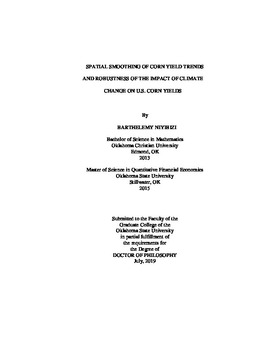| dc.contributor.advisor | Brorsen, B. Wade | |
| dc.contributor.author | Niyibizi, Barthelemy | |
| dc.date.accessioned | 2020-01-30T15:03:14Z | |
| dc.date.available | 2020-01-30T15:03:14Z | |
| dc.date.issued | 2019-07 | |
| dc.identifier.uri | https://hdl.handle.net/11244/323371 | |
| dc.description.abstract | In evaluating plans to mitigate climate change, policy makers require estimates of the cost of climate change. One potential cost of climate change is the negative effect that an increase in temperature would have on agricultural yields. We begin with a model suggested by Schlenker and Roberts (2009) and we are largely successful in replicating their results. We then modify the model to determine its robustness as we change assumption. These changes include (i) using long-term average data for temperature and precipitation variables instead of yearly data, (ii) temperature and precipitation data from different periods of the growing season, with an emphasis on critical corn growth periods, (iii) using a different method for estimating temperature exposure times, (iv) using two-knot time trends instead of quadratic time trends, (v) adding Corn Belt dummy variables, and (vi) removing data from the 1950s and 1960s. We make predictions of the impact of climate change under two warming scenarios (RCP4.5 and RCP8.5) of three General Circulation Models, and in each we make predictions with and without adaptation. The assumption change to which yield change predictions are most sensitive is the use of long-term average data instead of yearly data; predicted yield decreases based on models that use long-term average data are smaller by 18.0 percentage points compared to predictions based on models that use yearly data. | |
| dc.description.abstract | In the second chapter, Bayesian Kriging is used for spatial smoothing of yield density parameters, including time trends. There is a paucity of useful historical yield data for counties, but properly using other counties' information in the estimation of a county's yield density alleviates the problem of not having enough observations. Yield density parameters are assumed to be spatially correlated, through a Gaussian spatial process. The Bayesian Kriging model can handle unbalanced panel data. The forecast accuracy of our model is similar to that of Bayesian Model Averaging (BMA) that assumes a normal distribution, but our approach is the only one that provides the spatial smoothing desired by the Risk Management Agency. | |
| dc.format | application/pdf | |
| dc.language | en_US | |
| dc.rights | Copyright is held by the author who has granted the Oklahoma State University Library the non-exclusive right to share this material in its institutional repository. Contact Digital Library Services at lib-dls@okstate.edu or 405-744-9161 for the permission policy on the use, reproduction or distribution of this material. | |
| dc.title | Spatial Smoothing of Corn Yield Trends and Robustness of the Impact of Climate Change on U.S. Corn Yields | |
| dc.contributor.committeeMember | Lambert, Dayton M. | |
| dc.contributor.committeeMember | Biermacher, Jon T. | |
| dc.contributor.committeeMember | Alderman, Phillip | |
| osu.filename | Niyibizi_okstate_0664D_16381.pdf | |
| osu.accesstype | Open Access | |
| dc.type.genre | Dissertation | |
| dc.type.material | Text | |
| dc.subject.keywords | bayesian kriging | |
| dc.subject.keywords | climate change | |
| dc.subject.keywords | corn yield | |
| dc.subject.keywords | spatial smoothing | |
| dc.subject.keywords | temperature | |
| thesis.degree.discipline | Agricultural Economics | |
| thesis.degree.grantor | Oklahoma State University | |
